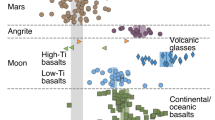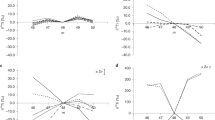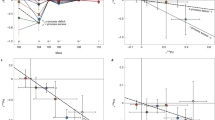Abstract
The chemical and isotopic homogeneity of the early solar nebula, and the processes producing fractionation during its evolution, are central issues of cosmochemistry. Studies of the relative abundance variations of three or more isotopes of an element can in principle determine if the initial reservoir of material was a homogeneous mixture or if it contained several distinct sources of precursor material. For example, widespread anomalies1,2,3,4 observed in the oxygen isotopes of meteorites have been interpreted as resulting from the mixing of a solid phase that was enriched in 16O with a gas phase in which 16O was depleted1,2,3, or as an isotopic ‘memory’ of Galactic evolution5. In either case, these anomalies are regarded as strong evidence that the early solar nebula was not initially homogeneous. Here we present measurements of the relative abundances of three iron isotopes in meteoritic and terrestrial samples. We show that significant variations of iron isotopes exist in both terrestrial and extraterrestrial materials. But when plotted in a three-isotope diagram, all of the data for these Solar System materials fall on a single mass-fractionation line, showing that homogenization of iron isotopes occurred in the solar nebula before both planetesimal accretion and chondrule formation.
This is a preview of subscription content, access via your institution
Access options
Subscribe to this journal
Receive 51 print issues and online access
$199.00 per year
only $3.90 per issue
Buy this article
- Purchase on Springer Link
- Instant access to full article PDF
Prices may be subject to local taxes which are calculated during checkout

Similar content being viewed by others
References
Clayton, R. N., Grossman, L. & Mayeda, T. K. A component of primitive nuclear composition in carbonaceous meteorites. Science 182, 485–488 (1973).
Clayton, R. N., Hinton, R. W. & Davis, A. M. Isotopic variations in the rock-forming elements in meteorites. Phil. Trans. R. Soc. Lond. A 325, 483–501 (1988).
Clayton, R. N. Oxygen isotopes in meteorites. Annu. Rev. Earth Planet. Sci. 21, 115–149 (1993).
Young, E. D. & Russell, S. S. Oxygen reservoirs in the early solar nebula inferred from an Allende CAI. Science 282, 452–455 (1998).
Clayton, D. D. Isotope anomalies: Chemical memory of galactic evolution. Astrophys. J. 334, 191–195 (1988).
Thiemens, M. H. & Heidenreich, J. E. The mass independent fractionation of oxygen: A novel isotope effect and its possible cosmochemical implications. Science 219, 1073–1075 (1983).
Thiemens, M. H. Atmosphere science—Mass-independent isotope effects in planetary atmospheres and the early solar system. Science 283, 341–345 (1999).
Cliff, S. S. & Thiemens, M. H. The 18O/16O and 17O/16O ratios in atmospheric nitrous oxide: A mass-independent anomaly. Science 278, 1774–1776 (1997).
Rockmann, T. et al. Mass-independent oxygen isotope fractionation in atmospheric CO as a result of the reaction CO + OH. Science 281, 544–546 (1998).
Bao, H. et al. Anomalous 17O compositions in massive sulphate deposits on the Earth. Nature 406, 176–178 (2000).
Bao, H., Campbell, D. A., Bockheim, J. G. & Thiemens, M. H. Origin of sulphate in Antarctic dry-valley soils as deduced from anomalous 17O compositions. Nature 407, 499–502 (2000).
Arnett, D. Supernovae and Nucleosynthesis (Princeton Univ. Press, Princeton, 1996).
Halliday, A. N. et al. Applications of multiple collector ICPMS to cosmochemistry, geochemistry and paleoceanography. Geochim. Cosmochim. Acta 62, 919–940 (1998).
Zhu, X. K., O'Nions, R. K., Guo, Y., Belshaw, N. S. & Rickard, D. Determination of natural Cu-isotope variation by plasma-source mass spectrometry: implications for use as geochemical tracers. Chem. Geol. 163, 139–149 (2000).
Zhu, X. K., O'Nions, R. K., Guo, Y. & Reynolds, B. C. Secular variation of iron isotopes in North Atlantic deep water. Science 287, 2000–2002 (2000).
Belshaw, N. S., Zhu, X. K., Guo, Y. & O'Nions, R. K. High precision measurement of iron isotopes by plasma source mass spectrometry. Int. J. Mass. Spectrom. 197, 191–195 (2000).
Marechal, C. N., Telouk, P. & Albarède, F. Precise analysis of copper and zinc isotopic compositions by plasma-source mass spectrometry. Chem. Geol. 156, 251–273 (1999).
Clayton, R. N. & Mayeda, T. K. Formation of ureilites by nebular processes. Geochim. Cosmochim. Acta 52, 1313–1318 (1988).
Clayton, R. N. & Mayeda, T. K. Oxygen isotope studies of achondrites. Geochim. Cosmochim. Acta 60, 1999–2017 (1996).
Clayton, R. N., Mayeda, T. K., Goswami, J. N. & Olsen, E. J. Oxygen isotope studies of ordinary chondrites. Geochim. Cosmochim. Acta 55, 2317–2337 (1991).
Volkening, J. & Papanastassiou, D. A. Iron isotope anomaly. Astrophys. J. 347, L43–L46 (1989).
Volkening, J. & Papanastassiou, D. A. Zinc isotope anomaly. Astrophys. J. 358, L29–L32 (1990).
Birck, J. L. & Lugmair, G. W. Nickel and chromium isotopes in Allende inclusions. Earth Planet. Sci. Lett. 90, 131–143 (1988).
Rotaru, M., Birck, J. L. & Allègre, C. J. Clue to early solar system history from chromium isotopes in carbonaceous chondrites. Nature 358, 465–470 (1992).
Podosek, F. A. et al. Thoroughly anomalous chromium in Orgueil. Meteorit. Planet. Sci. 32, 617–627 (1997).
Niemeyer, S. & Lugmair, G. W. Titanium isotopic anomalies in meteorites. Geochim. Cosmochim. Acta 48, 1401–1416 (1984).
Niemeyer, S. & Lugmair, G. W. Ubiquitous isotopic anomalies in Ti from normal Allende inclusions. Earth Planet. Sci. Lett. 53, 211–225 (1981).
Papanastassiou, D. A. Chromium isotopic anomalies in the Allende meteorite. Astrophys. J. 308, L27–L30 (1986).
Acknowledgements
We thank N. S. Belshaw for assistance with mass spectrometry; A. Galy for discussions and for providing solution aliquots of some samples analysed; G. Turner and F. Albarède for comments on the manuscript; and M. Price for providing samples of the Mt and OUM series. This work was supported by the Natural Environment Research Council.
Author information
Authors and Affiliations
Corresponding author
Rights and permissions
About this article
Cite this article
Zhu, X., Guo, Y., O'Nions, R. et al. Isotopic homogeneity of iron in the early solar nebula. Nature 412, 311–313 (2001). https://doi.org/10.1038/35085525
Received:
Accepted:
Issue Date:
DOI: https://doi.org/10.1038/35085525
This article is cited by
-
In situ geochemistry and Fe–O isotopic composition of iron oxides from the Pha Lek Fe deposit, northwest Truong Son orogenic belt, Laos: implications for ore-forming processes
Mineralium Deposita (2021)
-
Zinc, copper, and strontium isotopic variability in the Baiyangping Cu–Pb–Zn–Ag polymetallic ore field, Lanping Basin, Southwest China
Acta Geochimica (2021)
-
Non-traditional stable isotope geochemistry of marine ferromanganese crusts and nodules
Journal of Oceanography (2020)
-
Average iron isotopic compositions of the upper continental crust: constrained by loess from the Chinese Loess Plateau
Acta Geochimica (2017)
-
Investigation of matrix effects in the MC-ICP-MS induced by Nb, W, and Cu: Isotopic case studies of iron and copper
Chinese Journal of Geochemistry (2013)
Comments
By submitting a comment you agree to abide by our Terms and Community Guidelines. If you find something abusive or that does not comply with our terms or guidelines please flag it as inappropriate.



